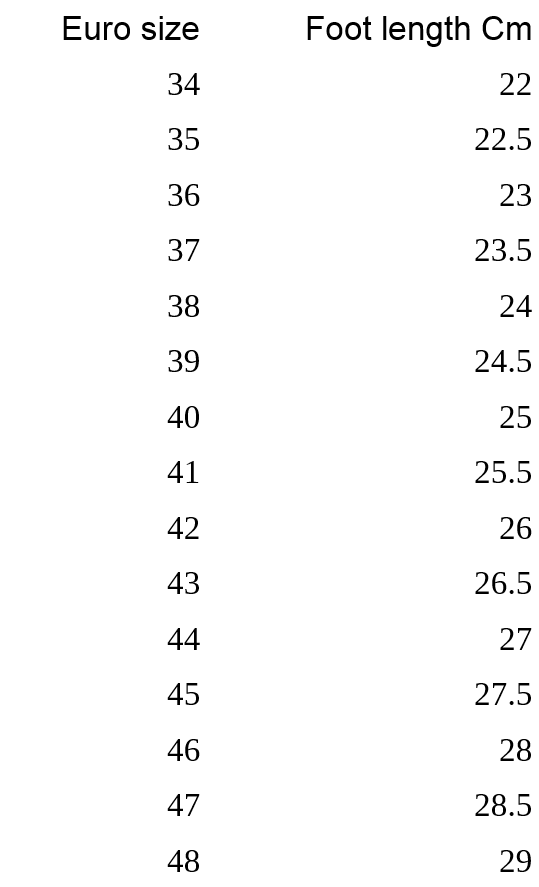
How To Measure Your Feet For European Sizing
At some time we’ve all seen shoes we would have loved to get but which ended up being too small or too big for us. Sometimes, we may even have purchased them, risking potential injury. Perhaps bleeding toes or foot calluses or even bunions. Knowing your shoe size is essential to buying shoes. But the problem is, there are NO STANDARD SHOE SIZES. When buying online, it is ESSENTIAL to measure your feet and compare these measurements with the size chart provided for the shoes you are interested in.
It is easy to find your foot length at home. Adults should measure their feet each year, anyway, to see if there have been any changes. For instance, age, pregnancy or an injury can change the size you need.
One way to measure your foot size is to trace your (BOTH) feet on paper and measure the length of each foot, from the heel to the end of the longest toe. Another way, is to stand on a piece of paper, with the edge of the paper and your heel against a wall and mark the end of your longest toe.
Once you have measured your foot length, look at the size chart to see what size of shoe you need.
Measuring Tips
1. Wear the same kind of socks or stockings you will be wearing when you wear the shoe.
2. To make sure you measure the length accurately, shift your weight forward in order to flatten your foot as it would be when walking.
3. If your measurement is between two sizes, always move up to the larger size.
4. Be sure to measure both feet.
5. When working out your shoe size from your foot length, fit to the larger of the two.
6. Measure your feet at a similar time as when you will be wearing the footwear.
7. For daily footwear, fit yourself when you’ve been on your feet all day because your feet will have expanded.
How To Measure
8. Tape a piece of paper to the floor.
9. Make sure you do this on a HARD surface, not on carpet or some surface that is flexible or hard to write on
10. If you are going to just measure the length of your foot, make sure the end of the paper fits closely to the edge of the wall and that the paper is perpendicular to the wall.
11. Place your foot firmly on top of the piece of paper, with your heel against the wall if you are just marking the length.
12. Bend your leg slightly, with your weight forward and make sure your shin is in front of your ankle.
13. If you are tracing the outline of your foot, you can stand or sit on a chair but still make sure you put your weight forward on your foot.
14. Draw the outline of your foot all the way around, if you are tracing. If you are just marking the length of your foot, make a pencil mark at your longest toe.
15. If you traced, measure your foot length from the back of your heel to the top of your longest toe. If you just marked the end of your longest toe, measure from the edge of the sheet of paper to the mark you made. DON’T GUESS!
16. Record the measurement in centimetres. Flip the paper over and repeat these steps with the other foot.
17. I hope I don’t need to say this, but do not wear shoes! It is important, though to wear socks or stocking similar to those you plan to wear with your new shoes.
Working Out Your Shoe Size
18. Use your length measurements to find your shoe size on the size chart FOR THE SHOES /BOOTS YOU WANT TO BUY. (Different manufacturers have different size charts.) If you are right at the end of one size group, you may need to go up a size or half size.
19. If between sizes, go to the next highest half size.
20. If one foot is longer than the other, buy a pair of shoes in the larger of the two sizes. Self-adhesive pads can be attached inside the heel of the shoe that goes on the smaller foot to keep it from slipping.
21. Shoe size alone will not always guarantee a perfect fit. Some people need more arch support or may need a lower cut front, if they have a high instep.
22. If you have wide feet, you MAY find that going up a size can give you a good fit, if the shoes are “medium”. Heel inserts or gel pads may help if your feet are narrow.